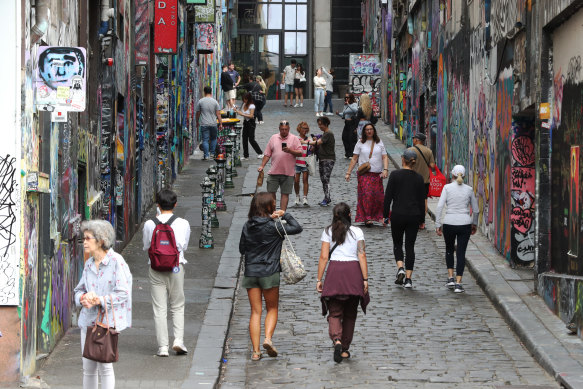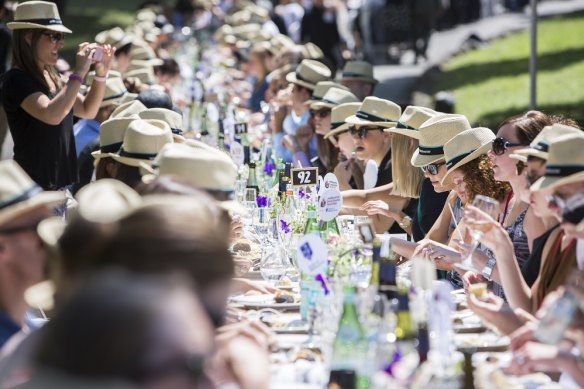This was published 2 years ago
Opinion
Melbourne’s CBD is dead. But what’s emerging might be even better
Cara Waters
The Age city editorDing-dong, Melbourne’s CBD is dead, but there’s no need to panic, the city is busy reinventing itself as a destination for entertainment and a place to live in the aftermath of the pandemic.
Despite some employers and lobby groups resorting to both threats and bribery, the bustle of office workers five days a week has not returned, but instead the city is buzzing at night and weekends.

Nature is healing with tourists back taking photos of graffiti in Hosier Lane. Credit: Eddie Jim
It’s not Melbourne as we knew it, but it’s a different Melbourne and it’s still kicking.
And this is the key point. We need to focus less on the “B” in Central Business District and put more emphasis on making the city centre a hub for living, meeting and being entertained.
We need to stop pretending it will go back to how it was. The latest Property Council figures show office occupancy at a measly 28 per cent of pre-COVID figures for January, even taking into account summer holidays it’s clear a shift has occurred.
Office workers aren’t staying away because of a few bike lanes, they are staying away because they have worked out that many jobs can be done perfectly well from home one or two days a week with the remainder of days in the office for in-person meetings.
This seemingly permanent shift to so-called “hybrid work”, which occurred during the pandemic, is the kiss of death for a city only focused on business.
So what can we do to change the city? In a planning scheme quirk, developers receive bonuses for building more offices in the city centre. Let’s instead incentivise them to include social housing, community and retail spaces in new developments.
Some public transport services could be shifted from peak hour to ensure more at nighttime and on weekends, with fewer shops selling sandwiches to office workers and more cafes and restaurants that are a destination in themselves.
Score yourself a seat at the bar and a cocktail at Gimlet in the evening, a ticket to Prima Facie at the Arts Centre or a spot on a plastic stool at Soi 83 for a serve of Thai noodles and you’ve hit the Melbourne jackpot.

The World’s Longest Lunch at the Melbourne Food & Wine Festival.Credit: Eddie Jim
Don’t shed too many tears for the tumbleweeds down Collins Street on Monday mornings – come Thursday evening it’s a different story with pedestrian traffic just below pre-COVID benchmarks.
Weekends are another bright spot for the city with people flocking in for festivals, sport, music, art, shopping, and theatre.
This will be turbocharged in “Mad March” when the city bursts at the seams with the frankly overwhelming combination of the Melbourne Food & Wine Festival, Melbourne Grand Prix, Melbourne Fashion Festival and Melbourne International Comedy Festival.
Then there’s the people making their home in the city with the latest City of Melbourne figures estimating there are 102,326 residential dwellings in the city centre, a number that has steadily climbed over the years.
The future of the city centre is mixed use, including housing, and it seems to be a no-brainer that some empty office buildings could be turned into apartments.
The transformation is already taking place in New York where America’s biggest office-to-residential conversion is under way. A skyscraper near the New York Stock Exchange is being retrofitted into 1300 apartments ranging from studios to four-bedroom dwellings.
We are yet to see plans for these conversions in Melbourne partly because they are costly and difficult to undertake.
Apartments require natural light which is often in short supply in offices and each home requires plumbing which is typically concentrated in just one area around the lift well in office buildings.
Still, the greatest barrier appears to be the lack of available properties due to building owners and managers hoping that things will go back to the way they were.
Associate professor of architecture at the University of Melbourne, Rory Hyde, says, “we are in a strange no man’s land where offices are empty, but space is not cheap”.
New buildings are often advertised as “mixed-use” but this just means residential or offices on top and half-empty retail below.
True mixed-use buildings in cities like London are encouraged through planning schemes where developers are incentivised to include community housing, libraries and theatres within developments.
It’s no longer a CBD, instead we could have a CED (central entertainment district) and CLD (central living district).
Whatever acronym you choose, the death of the CBD does not have to mean the death of the city centre.
The Opinion newsletter is a weekly wrap of views that will challenge, champion and inform your own. Sign up here.
More original opinions
Home invasion: Former Victorian Attorney-General and now director of the Centre for Innovative Justice, Rob Hulls, had his family home invaded while everyone was sleeping. He would like to meet the criminals and ask them why.
Enough with private schools: After a multitude of private school scandals Jenna Price calls to defund them all now and to also “examine the values these schools teach to an ever-increasing number of students enrolled”.
Death as a teacher: When Waleed Aly’s mother-in-law Jan was dying, he found these last moments to be beautiful and harrowing. “It’s also one of the most clarifying. The moment of death takes our vast, complex lives, and reveals them to be simple.”